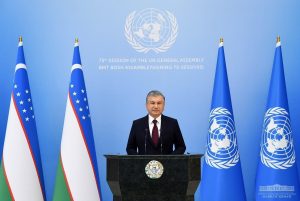The coronavirus pandemic has been the most significant test for the government of Uzbekistan since President Shavkat Mirziyoyev came to power in late 2016. The government demonstrated initial competence with its COVID-19 response, implementing an early lockdown, halting international and domestic travel, and using its extensive police force to enforce distancing measures. Mirziyoyev also took a leadership role within the Central Asian region, coordinating with other leaders on the cross-border flow of goods and citizens returning to their respective countries.
One particularly commendable area of the COVID-19 response has been the government’s efforts to assist the country’s approximately 2.5 million migrants working abroad, mostly in Russia. While many migrants were left stranded, often in squalid conditions, the Uzbek Foreign Ministry made unprecedented efforts to charter flights or coaches to provide safe passage home. This is a significant change in attitude compared with the previous government of Islam Karimov, who refused to recognize the phenomenon of economic migration and its importance to the Uzbek economy.
However, there were serious failings at the operational level, particularly as the lockdown lifted in May and Uzbekistan’s case rate rapidly spiked, averaging more than 700 cases per day by early August. Hospitals across the country were quickly overwhelmed, a clear sign that efforts to prepare the health system for a new wave of cases had not succeeded, despite the government’s claims to the contrary. The sheer number of patients presenting at hospitals with COVID-19 symptoms also raised questions over the government’s official statistics, suggesting that it either lacked the testing capacity to diagnose cases or was not prepared to present the real statistics publicly. Activists have also claimed that coronavirus support funds have been distributed in a non-transparent fashion, potentially to politically connected businesses.
Both the successes and the failings of the COVID-19 response have revealed much about the capabilities of the administration of Mirziyoyev, self-styled as a reformer heading a progressive government with ambitious plans. In February 2017, just months into his presidency, Mirziyoyev presented a wide ranging and ambitious reform strategy, covering areas as disparate as education, national security, and economic development.
Since then, a huge slew of reforms have been passed — largely by presidential degree. The desire to maintain momentum in the reform effort has, however, meant that oversight has been weak and the quality of the measures has consistently suffered, often causing legislation to be amended and reissued soon after its initial adoption. Moreover, much like the COVID-19 response, there remains a significant gap between the ambitions aired at the top and the results on the ground. Delivery has been extremely uneven due to a combination of lack of capacity — particularly human capital — and resistance at the mid and lower levels of the civil service, especially within regional administrations.
The reform rhetoric may have also extended further than the government is prepared to actually go. On the political front, there has been little in the way of liberalization, meaning that activists and journalists still find themselves subject to pursuit by the security services. With the population facing a decline in living standards due to the pandemic, the government has passed new legislation making it even more difficult for activists to hold public protests. On the economic front, structural reforms, such as privatization, anti-corruption drives, and measures to break up monopolies, have all been adopted. However, like COVID-19 aid, these instruments have been used not only to stimulate growth but to benefit economic groups with strong political connections.
The success of the reform program is not only critical to Mirziyoyev’s political fortunes. It is also an existential question for Uzbekistan. With 33 million people, Uzbekistan is Central Asia’s most populous country and has consistently struggled to secure basic living standards for all of its population. Two of the government’s primary aims are to support employment and end shortages of gas and electricity supplies. To add to this challenge, Uzbekistan is also experiencing a demographic boom, which will see more than 600,000 people join the workforce each year until at least 2025. Due to the pandemic, even more workers have entered the workforce this year as migrant laborers return home and many that were previously not in the labor market seek new employment as living conditions become more difficult.
The government is therefore in a race against the clock to ensure that it can deliver for its rapidly growing population. The entire 2017 strategy is designed to meet this challenge by enacting diverse measures such as supporting the passage of migrant workers to new destinations such as South Korea and the United Arab Emirates, diverting gas exports to serve domestic demand, capital markets reform, and reforming preschool and university education. In February this year, Mirziyoyev also set a target of doubling GDP by 2025, a goal that was within reach until the pandemic struck. The coronavirus crisis has resulted in a dramatic drop in growth expectations for 2020, from over 5 percent to less than 2 percent, according to the IMF — a severe blow to the president’s ambitions.
The government has also made much of its efforts to tackle the totemic issue of forced labor in the country’s cotton fields, winning plaudits from the International Labor Organization (ILO). While progress has been made, much of this is the result of top-down efforts rather than institutional change, suggesting that there is still the possibility of abusive practices returning. For this reason, international apparel brands continue to hold off from buying Uzbek cotton.
In his address to the UN General Assembly this week, Mirziyoyev was quick to highlight the progress made in the three years since he introduced his reform strategy. However, the coronavirus pandemic has not only presented a severe blow to the president’s ambitions, it has highlighted the distance the government still has to travel to deliver on its strategy.
Benjamin Godwin is head of analysis at PRISM Political Risk Management.

































